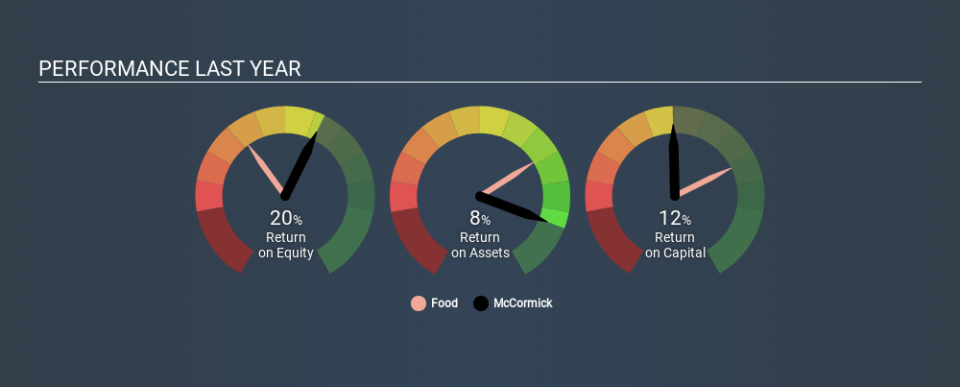Why We Like McCormick & Company, Incorporated’s (NYSE:MKC) 12% Return On Capital Employed

Today we'll evaluate McCormick & Company, Incorporated (NYSE:MKC) to determine whether it could have potential as an investment idea. Specifically, we'll consider its Return On Capital Employed (ROCE), since that will give us an insight into how efficiently the business can generate profits from the capital it requires.
First, we'll go over how we calculate ROCE. Next, we'll compare it to others in its industry. Then we'll determine how its current liabilities are affecting its ROCE.
What is Return On Capital Employed (ROCE)?
ROCE is a metric for evaluating how much pre-tax income (in percentage terms) a company earns on the capital invested in its business. In general, businesses with a higher ROCE are usually better quality. In brief, it is a useful tool, but it is not without drawbacks. Renowned investment researcher Michael Mauboussin has suggested that a high ROCE can indicate that 'one dollar invested in the company generates value of more than one dollar'.
How Do You Calculate Return On Capital Employed?
The formula for calculating the return on capital employed is:
Return on Capital Employed = Earnings Before Interest and Tax (EBIT) ÷ (Total Assets - Current Liabilities)
Or for McCormick:
0.12 = US$986m ÷ (US$10b - US$2.0b) (Based on the trailing twelve months to August 2019.)
Therefore, McCormick has an ROCE of 12%.
See our latest analysis for McCormick
Does McCormick Have A Good ROCE?
ROCE is commonly used for comparing the performance of similar businesses. McCormick's ROCE appears to be substantially greater than the 8.9% average in the Food industry. We consider this a positive sign, because it suggests it uses capital more efficiently than similar companies. Regardless of where McCormick sits next to its industry, its ROCE in absolute terms appears satisfactory, and this company could be worth a closer look.
McCormick's current ROCE of 12% is lower than 3 years ago, when the company reported a 20% ROCE. This makes us wonder if the business is facing new challenges. You can see in the image below how McCormick's ROCE compares to its industry. Click to see more on past growth.
It is important to remember that ROCE shows past performance, and is not necessarily predictive. ROCE can be deceptive for cyclical businesses, as returns can look incredible in boom times, and terribly low in downturns. ROCE is, after all, simply a snap shot of a single year. Since the future is so important for investors, you should check out our free report on analyst forecasts for McCormick.
What Are Current Liabilities, And How Do They Affect McCormick's ROCE?
Short term (or current) liabilities, are things like supplier invoices, overdrafts, or tax bills that need to be paid within 12 months. The ROCE equation subtracts current liabilities from capital employed, so a company with a lot of current liabilities appears to have less capital employed, and a higher ROCE than otherwise. To counter this, investors can check if a company has high current liabilities relative to total assets.
McCormick has total liabilities of US$2.0b and total assets of US$10b. As a result, its current liabilities are equal to approximately 20% of its total assets. Current liabilities are minimal, limiting the impact on ROCE.
What We Can Learn From McCormick's ROCE
This is good to see, and with a sound ROCE, McCormick could be worth a closer look. McCormick looks strong on this analysis, but there are plenty of other companies that could be a good opportunity . Here is a free list of companies growing earnings rapidly.
If you like to buy stocks alongside management, then you might just love this free list of companies. (Hint: insiders have been buying them).
If you spot an error that warrants correction, please contact the editor at editorial-team@simplywallst.com. This article by Simply Wall St is general in nature. It does not constitute a recommendation to buy or sell any stock, and does not take account of your objectives, or your financial situation. Simply Wall St has no position in the stocks mentioned.
We aim to bring you long-term focused research analysis driven by fundamental data. Note that our analysis may not factor in the latest price-sensitive company announcements or qualitative material. Thank you for reading.

 Yahoo Finance
Yahoo Finance 
